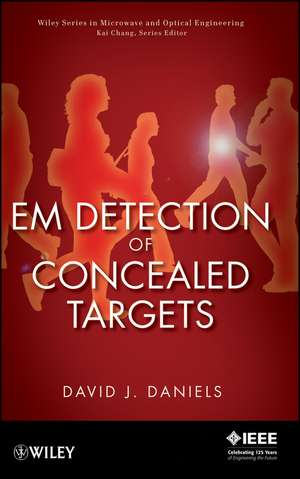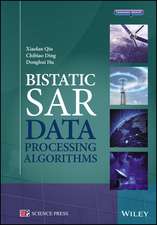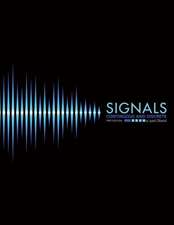EM Detection of Concealed Targets: Wiley Series in Microwave and Optical Engineering
Autor DJ Danielsen Limba Engleză Hardback – 11 ian 2010
Din seria Wiley Series in Microwave and Optical Engineering
- 24%
 Preț: 839.62 lei
Preț: 839.62 lei - 9%
 Preț: 724.40 lei
Preț: 724.40 lei - 9%
 Preț: 1484.37 lei
Preț: 1484.37 lei - 9%
 Preț: 1269.67 lei
Preț: 1269.67 lei - 9%
 Preț: 748.72 lei
Preț: 748.72 lei - 9%
 Preț: 1233.54 lei
Preț: 1233.54 lei - 9%
 Preț: 1051.24 lei
Preț: 1051.24 lei - 9%
 Preț: 773.26 lei
Preț: 773.26 lei - 9%
 Preț: 1448.43 lei
Preț: 1448.43 lei - 9%
 Preț: 844.67 lei
Preț: 844.67 lei - 9%
 Preț: 962.34 lei
Preț: 962.34 lei - 9%
 Preț: 1294.72 lei
Preț: 1294.72 lei - 9%
 Preț: 1266.53 lei
Preț: 1266.53 lei - 9%
 Preț: 1463.96 lei
Preț: 1463.96 lei - 9%
 Preț: 808.71 lei
Preț: 808.71 lei - 9%
 Preț: 1386.11 lei
Preț: 1386.11 lei - 9%
 Preț: 1048.49 lei
Preț: 1048.49 lei - 9%
 Preț: 885.35 lei
Preț: 885.35 lei - 9%
 Preț: 1023.70 lei
Preț: 1023.70 lei - 9%
 Preț: 1156.52 lei
Preț: 1156.52 lei - 9%
 Preț: 1203.93 lei
Preț: 1203.93 lei - 9%
 Preț: 1108.07 lei
Preț: 1108.07 lei - 9%
 Preț: 1065.12 lei
Preț: 1065.12 lei - 9%
 Preț: 1228.62 lei
Preț: 1228.62 lei - 9%
 Preț: 1084.30 lei
Preț: 1084.30 lei - 9%
 Preț: 1357.61 lei
Preț: 1357.61 lei - 9%
 Preț: 1579.71 lei
Preț: 1579.71 lei - 9%
 Preț: 1418.62 lei
Preț: 1418.62 lei - 9%
 Preț: 934.98 lei
Preț: 934.98 lei - 9%
 Preț: 1096.97 lei
Preț: 1096.97 lei - 9%
 Preț: 1101.80 lei
Preț: 1101.80 lei - 9%
 Preț: 1213.91 lei
Preț: 1213.91 lei - 9%
 Preț: 1339.55 lei
Preț: 1339.55 lei - 9%
 Preț: 866.27 lei
Preț: 866.27 lei - 9%
 Preț: 1797.25 lei
Preț: 1797.25 lei - 9%
 Preț: 1160.31 lei
Preț: 1160.31 lei - 9%
 Preț: 801.17 lei
Preț: 801.17 lei - 9%
 Preț: 1276.33 lei
Preț: 1276.33 lei - 9%
 Preț: 1423.37 lei
Preț: 1423.37 lei - 9%
 Preț: 1095.58 lei
Preț: 1095.58 lei - 9%
 Preț: 970.80 lei
Preț: 970.80 lei - 9%
 Preț: 1174.76 lei
Preț: 1174.76 lei - 9%
 Preț: 1344.87 lei
Preț: 1344.87 lei - 9%
 Preț: 1334.03 lei
Preț: 1334.03 lei - 9%
 Preț: 1006.11 lei
Preț: 1006.11 lei - 9%
 Preț: 1068.04 lei
Preț: 1068.04 lei - 9%
 Preț: 1073.60 lei
Preț: 1073.60 lei - 9%
 Preț: 1191.14 lei
Preț: 1191.14 lei - 9%
 Preț: 1078.27 lei
Preț: 1078.27 lei - 9%
 Preț: 1364.55 lei
Preț: 1364.55 lei
Preț: 961.10 lei
Preț vechi: 1056.15 lei
-9% Nou
Puncte Express: 1442
Preț estimativ în valută:
183.93€ • 191.32$ • 151.84£
183.93€ • 191.32$ • 151.84£
Carte tipărită la comandă
Livrare economică 15-29 aprilie
Preluare comenzi: 021 569.72.76
Specificații
ISBN-13: 9780470121696
ISBN-10: 0470121696
Pagini: 304
Dimensiuni: 161 x 246 x 18 mm
Greutate: 0.57 kg
Editura: Wiley
Seria Wiley Series in Microwave and Optical Engineering
Locul publicării:Hoboken, United States
ISBN-10: 0470121696
Pagini: 304
Dimensiuni: 161 x 246 x 18 mm
Greutate: 0.57 kg
Editura: Wiley
Seria Wiley Series in Microwave and Optical Engineering
Locul publicării:Hoboken, United States
Public țintă
Researchers and developers, program managers for security agencies, electrical and electronics engineers, radar and remote sensing specialists; applied physicists; and staff working in security and defense.Descriere
The latest EM techniques for detecting concealed targets, whether explosives, weapons, or people Extensively illustrated from basic principles to system design, the fundamental concepts of RF, microwave, millimeter wave, and terahertz detection systems and techniques to find concealed targets are explained in this publication. These concealed targets may be explosive devices or weapons, which can be buried in the ground, concealed in building structures, hidden under clothing, or inside luggage. Concealed targets may also be people who are stowaways or victims of an avalanche or earthquake.
Although much information is available in conference proceedings and professional society publications, this book brings all the relevant information in a single, expertly written and organized volume.
Readers gain an understanding of the physics underlying electromagnetic (EM) detection methods, as well as the factors that affect the performance of EM detection equipment, helping them choose the right type of equipment and techniques to meet the demands of particular tasks. Among the topics covered are:
Although much information is available in conference proceedings and professional society publications, this book brings all the relevant information in a single, expertly written and organized volume.
Readers gain an understanding of the physics underlying electromagnetic (EM) detection methods, as well as the factors that affect the performance of EM detection equipment, helping them choose the right type of equipment and techniques to meet the demands of particular tasks. Among the topics covered are:
- Ultra–wideband radar and ground–penetrating radar
- Millimeter, sub–millimeter, and terahertz systems
- Radar systems including Doppler, harmonic, impulse, FMCW, and holographic
- Radiometric systems
- Nuclear quadrupole resonance systems
Textul de pe ultima copertă
The latest EM techniques for detecting concealed targets, whether explosives, weapons, or people Extensively illustrated from basic principles to system design, the fundamental concepts of RF, microwave, millimeter wave, and terahertz detection systems and techniques to find concealed targets are explained in this publication. These concealed targets may be explosive devices or weapons, which can be buried in the ground, concealed in building structures, hidden under clothing, or inside luggage. Concealed targets may also be people who are stowaways or victims of an avalanche or earthquake.
Although much information is available in conference proceedings and professional society publications, this book brings all the relevant information in a single, expertly written and organized volume.
Readers gain an understanding of the physics underlying electromagnetic (EM) detection methods, as well as the factors that affect the performance of EM detection equipment, helping them choose the right type of equipment and techniques to meet the demands of particular tasks. Among the topics covered are:
Although much information is available in conference proceedings and professional society publications, this book brings all the relevant information in a single, expertly written and organized volume.
Readers gain an understanding of the physics underlying electromagnetic (EM) detection methods, as well as the factors that affect the performance of EM detection equipment, helping them choose the right type of equipment and techniques to meet the demands of particular tasks. Among the topics covered are:
- Ultra–wideband radar and ground–penetrating radar
- Millimeter, sub–millimeter, and terahertz systems
- Radar systems including Doppler, harmonic, impulse, FMCW, and holographic
- Radiometric systems
- Nuclear quadrupole resonance systems
Cuprins
Preface. Acknowledgments.
List of Frequently used Acronyms.
1 Introduction.
1.1 Scope and Objectives.
1.2 Structure.
1.3 Market Needs for Security.
1.4 Targets inside Containers.
1.5 Buried Land Mines.
1.6 Forensic Detection of Buried Bodies.
1.7 Avalanche and Earthquake Victims.
1.8 Concealed Humans.
1.9 Concealed Targets on Humans.
1.10 Radiological Considerations.
1.11 Licensing Considerations.
1.12 Statistics of the Detection Performance of a Sensor.
1.13 Summary.
2 Physics of Propagation.
2.1 Introduction.
2.2 Propagation of Electromagnetic Fields in Free Space.
2.2.1 Reactive Fields.
2.2.2 Near Fields.
2.2.3 Far Fields.
2.2.4 Polarization.
2.2.5 Radar Cross Section.
2.2.6 Reflection.
2.2.7 Refraction.
2.2.8 Brewster Angle.
2.2.9 Dispersion.
2.2.10 Anisotropy.
2.2.11 Clutter.
2.3 Propagation of Energy in a Dielectric.
2.3.1 Introduction.
2.3.2 Velocity in a Dielectric.
2.3.3 Impedance of a Dielectric.
2.3.4 Propagation Loss in a Dielectric.
2.3.5 Coupling Losses into Materials.
2.4 Dielectric Properties of Soils and Rocks.
2.5 Propagation in Water.
2.6 Atmospheric Absorption of Electromagnetic Waves.
2.6.1 Rain and Fog.
2.6.2 Dust, Smoke, and Sand Storms.
2.7 Attenuation of Electromagnetic Fields by Materials.
2.7.1 Human and Animal.
2.7.2 Heartbeat.
2.7.3 Respiration.
2.7.4 Clothing.
2.7.5 Construction Materials.
2.7.6 Explosives.
2.8 Summary.
3 Antennas.
3.1 Introduction.
3.2 Antenna Parameters.
3.2.1 Antenna Directivity.
3.2.2 Antenna Gain.
3.2.3 Antenna Efficiency.
3.2.4 Side Lobes and Back Lobes.
3.2.5 Bandwidth.
3.2.6 Polarization Linear, Elliptical, and Circular.
3.2.7 Antenna Phase Center.
3.2.8 Antenna Patterns.
3.2.9 Time Side Lobes and Ring–down.
3.2.10 Antenna Footprint.
3.3 Aperture Antennas.
3.4 Antennas for Proximal Operation.
3.4.1 Introduction.
3.4.2 Coupling Energy into the Ground or a Dielectric.
3.5 Linear Phase Antennas.
3.5.1 Dipoles.
3.5.2 Loaded Antennas.
3.5.3 BiConical Antennas.
3.5.4 Bow–Tie Antennas.
3.5.5 Dielectric Road Antennas.
3.5.6 TEM Horn Antennas.
3.5.7 Impulse Radiating Antennas.
3.6 Nonlinear Phase Antennas.
3.6.1 Vivaldi Antennas.
3.6.2 Equiangular Antennas.
3.6.3 Horn Antennas.
3.7 Antenna Arrays.
3.8 Summary.
4 Nuclear Quadrupole Resonance.
4.1 Introduction.
4.2 Pulse Sequences.
4.3 System Design.
4.3.1 Introduction.
4.3.2 Transmit–and–Receive Coils.
4.3.3 Receiver and Coil Considerations.
4.4 Signal Processing.
4.5 Detection of Explosives.
4.6 Land–Mine Detection.
4.7 Illicit Drugs.
4.7.1 Cocaine.
4.7.2 Cocaine Hydrochloride.
4.7.3 Heroin (Diamorphine).
4.8 Summary.
5 Radar Systems.
5.1 Introduction.
5.2 Doppler Radar Systems.
5.3 Frequency–Domain Radars.
5.3.1 Introduction.
5.3.2 Two–Frequency Doppler Radar.
5.3.3 Stepped Frequency Radar Systems.
5.3.4 Frequency–Modulated Continuous–Wave Radar.
5.4 Harmonic Radar.
5.5 Noise Radar.
5.6 Spatial Modulation.
5.7 Amplitude Modulation.
5.8 Summary.
6 Passive Systems.
6.1 Introduction.
6.2 Principles of Radiometry.
6.3 Total Power Radiometer.
6.4 Dicke Radiometer.
6.5 Minimum Detectable Temperature.
6.6 Temperature Resolution.
6.7 Imaging Systems.
6.8 Summary.
7 Applications and Technology.
7.1 Introduction.
7.2 Physiological Monitoring.
7.3 Earthquake and Avalanche Radar Systems.
7.4 Forensic Applications.
7.5 Through–Wall Radar (TWR) for Surveillance.
7.6 Harmonic Radar Systems.
7.7 Land–Mine Detection Radar Systems.
7.7.1 Handheld Land–Mine Detection Radar Systems.
7.7.2 Vehicle–Mounted Land–Mine Detection Radar Systems.
7.8 Radar for General Search Operations.
7.9 Spatially Modulated Systems.
7.10 Millimeter–Wave Radar Systems.
7.11 Summary.
8 Summary.
References.
Index.
List of Frequently used Acronyms.
1 Introduction.
1.1 Scope and Objectives.
1.2 Structure.
1.3 Market Needs for Security.
1.4 Targets inside Containers.
1.5 Buried Land Mines.
1.6 Forensic Detection of Buried Bodies.
1.7 Avalanche and Earthquake Victims.
1.8 Concealed Humans.
1.9 Concealed Targets on Humans.
1.10 Radiological Considerations.
1.11 Licensing Considerations.
1.12 Statistics of the Detection Performance of a Sensor.
1.13 Summary.
2 Physics of Propagation.
2.1 Introduction.
2.2 Propagation of Electromagnetic Fields in Free Space.
2.2.1 Reactive Fields.
2.2.2 Near Fields.
2.2.3 Far Fields.
2.2.4 Polarization.
2.2.5 Radar Cross Section.
2.2.6 Reflection.
2.2.7 Refraction.
2.2.8 Brewster Angle.
2.2.9 Dispersion.
2.2.10 Anisotropy.
2.2.11 Clutter.
2.3 Propagation of Energy in a Dielectric.
2.3.1 Introduction.
2.3.2 Velocity in a Dielectric.
2.3.3 Impedance of a Dielectric.
2.3.4 Propagation Loss in a Dielectric.
2.3.5 Coupling Losses into Materials.
2.4 Dielectric Properties of Soils and Rocks.
2.5 Propagation in Water.
2.6 Atmospheric Absorption of Electromagnetic Waves.
2.6.1 Rain and Fog.
2.6.2 Dust, Smoke, and Sand Storms.
2.7 Attenuation of Electromagnetic Fields by Materials.
2.7.1 Human and Animal.
2.7.2 Heartbeat.
2.7.3 Respiration.
2.7.4 Clothing.
2.7.5 Construction Materials.
2.7.6 Explosives.
2.8 Summary.
3 Antennas.
3.1 Introduction.
3.2 Antenna Parameters.
3.2.1 Antenna Directivity.
3.2.2 Antenna Gain.
3.2.3 Antenna Efficiency.
3.2.4 Side Lobes and Back Lobes.
3.2.5 Bandwidth.
3.2.6 Polarization Linear, Elliptical, and Circular.
3.2.7 Antenna Phase Center.
3.2.8 Antenna Patterns.
3.2.9 Time Side Lobes and Ring–down.
3.2.10 Antenna Footprint.
3.3 Aperture Antennas.
3.4 Antennas for Proximal Operation.
3.4.1 Introduction.
3.4.2 Coupling Energy into the Ground or a Dielectric.
3.5 Linear Phase Antennas.
3.5.1 Dipoles.
3.5.2 Loaded Antennas.
3.5.3 BiConical Antennas.
3.5.4 Bow–Tie Antennas.
3.5.5 Dielectric Road Antennas.
3.5.6 TEM Horn Antennas.
3.5.7 Impulse Radiating Antennas.
3.6 Nonlinear Phase Antennas.
3.6.1 Vivaldi Antennas.
3.6.2 Equiangular Antennas.
3.6.3 Horn Antennas.
3.7 Antenna Arrays.
3.8 Summary.
4 Nuclear Quadrupole Resonance.
4.1 Introduction.
4.2 Pulse Sequences.
4.3 System Design.
4.3.1 Introduction.
4.3.2 Transmit–and–Receive Coils.
4.3.3 Receiver and Coil Considerations.
4.4 Signal Processing.
4.5 Detection of Explosives.
4.6 Land–Mine Detection.
4.7 Illicit Drugs.
4.7.1 Cocaine.
4.7.2 Cocaine Hydrochloride.
4.7.3 Heroin (Diamorphine).
4.8 Summary.
5 Radar Systems.
5.1 Introduction.
5.2 Doppler Radar Systems.
5.3 Frequency–Domain Radars.
5.3.1 Introduction.
5.3.2 Two–Frequency Doppler Radar.
5.3.3 Stepped Frequency Radar Systems.
5.3.4 Frequency–Modulated Continuous–Wave Radar.
5.4 Harmonic Radar.
5.5 Noise Radar.
5.6 Spatial Modulation.
5.7 Amplitude Modulation.
5.8 Summary.
6 Passive Systems.
6.1 Introduction.
6.2 Principles of Radiometry.
6.3 Total Power Radiometer.
6.4 Dicke Radiometer.
6.5 Minimum Detectable Temperature.
6.6 Temperature Resolution.
6.7 Imaging Systems.
6.8 Summary.
7 Applications and Technology.
7.1 Introduction.
7.2 Physiological Monitoring.
7.3 Earthquake and Avalanche Radar Systems.
7.4 Forensic Applications.
7.5 Through–Wall Radar (TWR) for Surveillance.
7.6 Harmonic Radar Systems.
7.7 Land–Mine Detection Radar Systems.
7.7.1 Handheld Land–Mine Detection Radar Systems.
7.7.2 Vehicle–Mounted Land–Mine Detection Radar Systems.
7.8 Radar for General Search Operations.
7.9 Spatially Modulated Systems.
7.10 Millimeter–Wave Radar Systems.
7.11 Summary.
8 Summary.
References.
Index.
Notă biografică
David J. Daniels, BSc, MSc, CEng, FIET, SMIEE, is the Chief Consultant for Sensors at Cobham Technical Services (formerly known as ERA Technology). David has more than thirty years of experience in the development of radar, acoustic, and electromagnetic systems as well as products for security, sensing, and test applications for the military and commercial enterprises. He has brought such products to market as acoustic detection systems, fiber optic cryogenic liquid leak sensors, marine radar rescue transponders, ultra–wideband microwave amplifiers, ground–penetrating radar, land–mine detectors, and RF and microwave security systems. His current interests center on sensor systems for land–mine detection, homeland security, and military counterterrorist activities.















